Business Management Report: Comparing China and Australia's Cultures
VerifiedAdded on 2020/04/15
|12
|2816
|59
Report
AI Summary
This report provides an in-depth analysis of China's market culture, comparing it to Australia's business environment. It begins with an executive summary outlining the key factors influencing China's market, such as its emerging market status, GDP growth, and labor force. The report then delves into the historical context of both countries, followed by an examination of China's unique market culture, including the impact of cultural factors and consumer behavior. A comparison of business cultures between China and Australia is presented, highlighting key differences. The analysis utilizes Hofstede's cultural dimensions to provide a framework for understanding these differences. The report concludes by offering recommendations for foreign companies seeking to compete and succeed in the Chinese market, based on the cultural insights gained from the analysis. The report uses secondary data and provides valuable insights for international businesses.
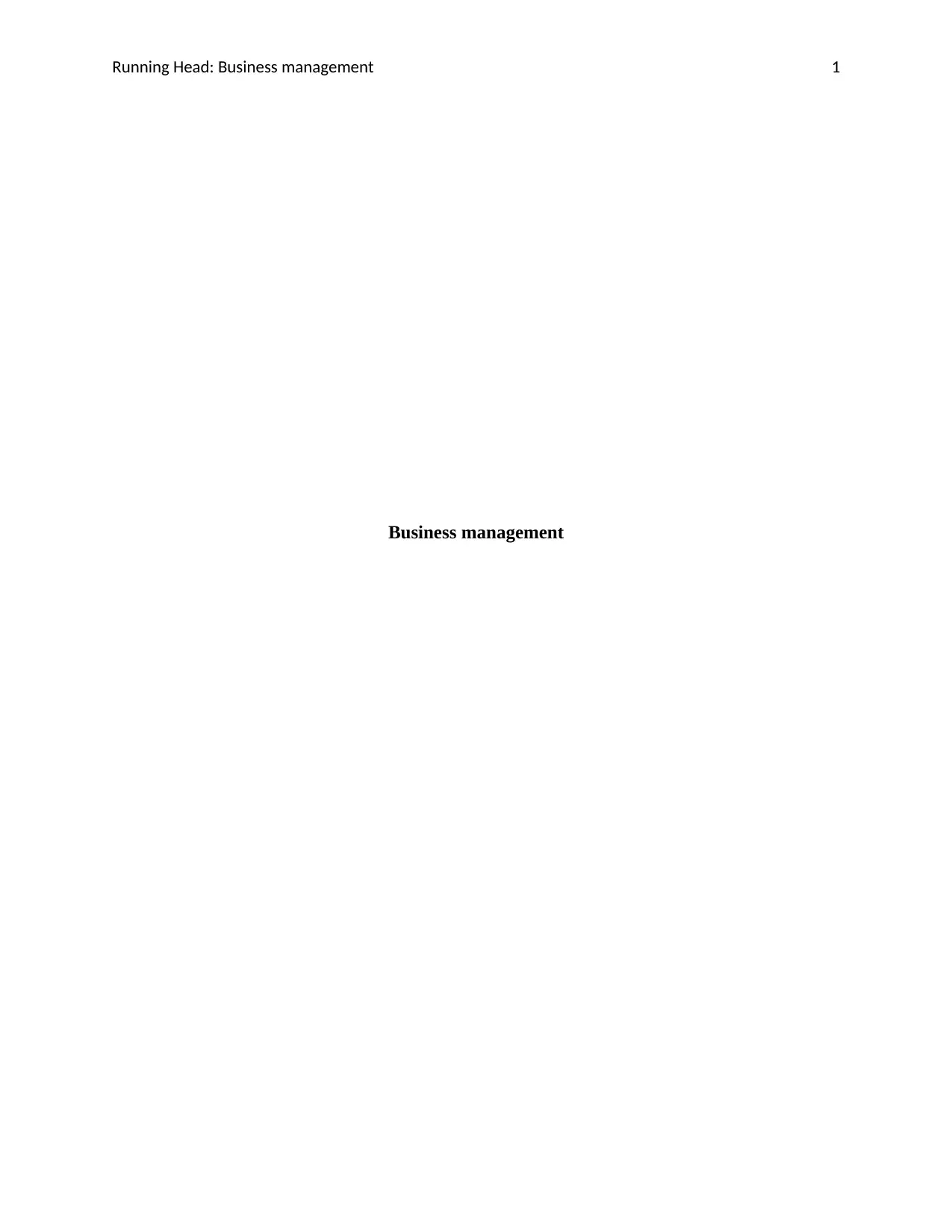
Running Head: Business management 1
Business management
Business management
Paraphrase This Document
Need a fresh take? Get an instant paraphrase of this document with our AI Paraphraser
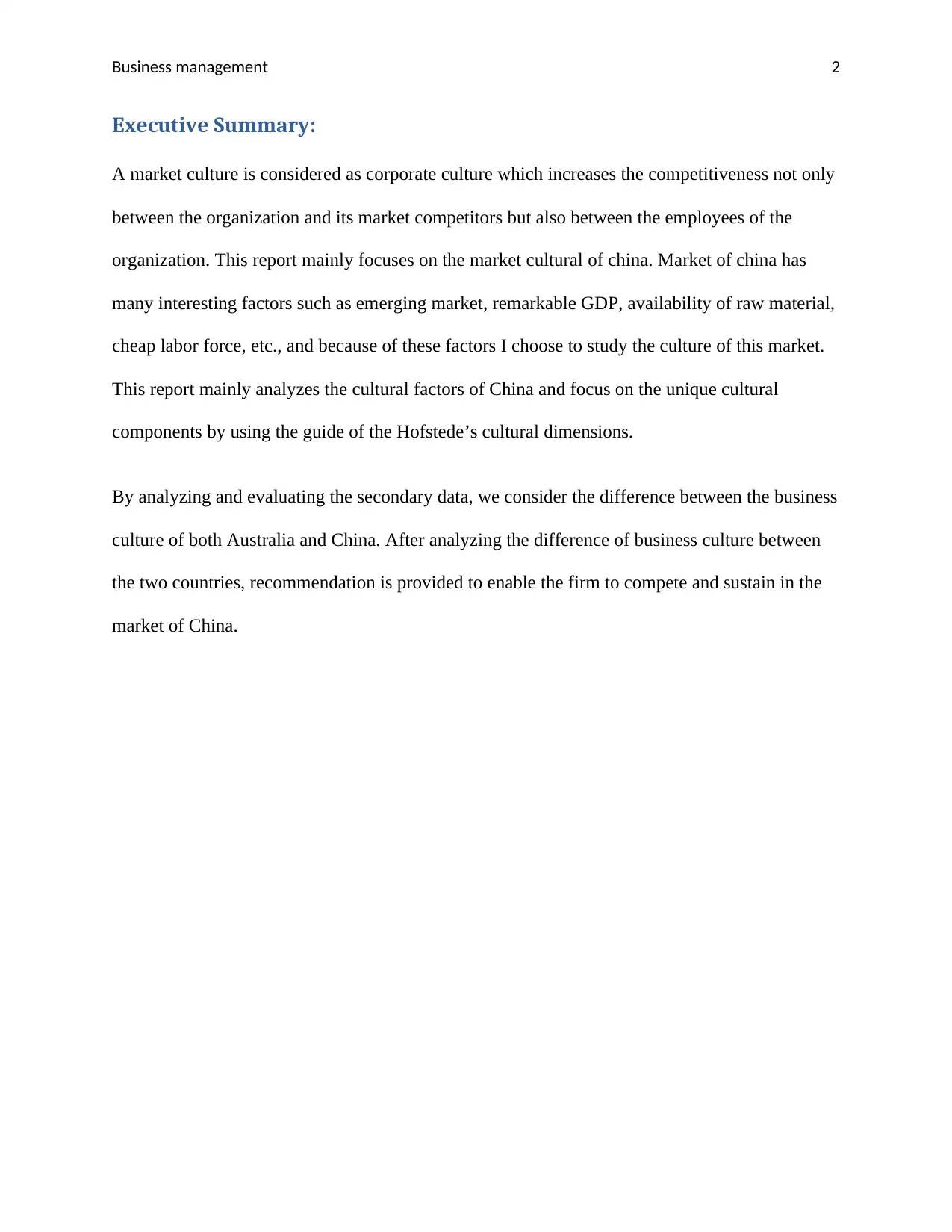
Business management 2
Executive Summary:
A market culture is considered as corporate culture which increases the competitiveness not only
between the organization and its market competitors but also between the employees of the
organization. This report mainly focuses on the market cultural of china. Market of china has
many interesting factors such as emerging market, remarkable GDP, availability of raw material,
cheap labor force, etc., and because of these factors I choose to study the culture of this market.
This report mainly analyzes the cultural factors of China and focus on the unique cultural
components by using the guide of the Hofstede’s cultural dimensions.
By analyzing and evaluating the secondary data, we consider the difference between the business
culture of both Australia and China. After analyzing the difference of business culture between
the two countries, recommendation is provided to enable the firm to compete and sustain in the
market of China.
Executive Summary:
A market culture is considered as corporate culture which increases the competitiveness not only
between the organization and its market competitors but also between the employees of the
organization. This report mainly focuses on the market cultural of china. Market of china has
many interesting factors such as emerging market, remarkable GDP, availability of raw material,
cheap labor force, etc., and because of these factors I choose to study the culture of this market.
This report mainly analyzes the cultural factors of China and focus on the unique cultural
components by using the guide of the Hofstede’s cultural dimensions.
By analyzing and evaluating the secondary data, we consider the difference between the business
culture of both Australia and China. After analyzing the difference of business culture between
the two countries, recommendation is provided to enable the firm to compete and sustain in the
market of China.
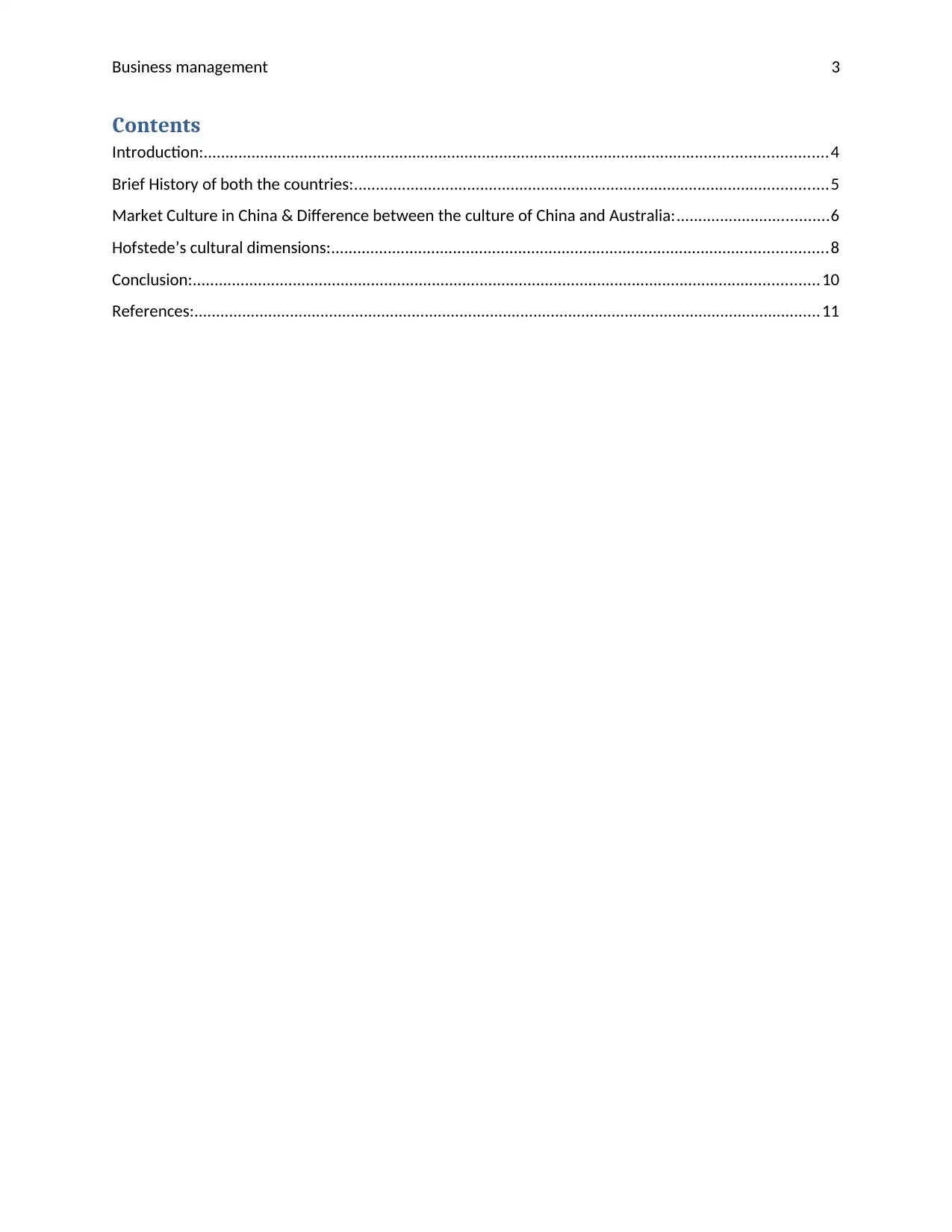
Business management 3
Contents
Introduction:...............................................................................................................................................4
Brief History of both the countries:.............................................................................................................5
Market Culture in China & Difference between the culture of China and Australia:...................................6
Hofstede’s cultural dimensions:..................................................................................................................8
Conclusion:................................................................................................................................................10
References:................................................................................................................................................11
Contents
Introduction:...............................................................................................................................................4
Brief History of both the countries:.............................................................................................................5
Market Culture in China & Difference between the culture of China and Australia:...................................6
Hofstede’s cultural dimensions:..................................................................................................................8
Conclusion:................................................................................................................................................10
References:................................................................................................................................................11
⊘ This is a preview!⊘
Do you want full access?
Subscribe today to unlock all pages.

Trusted by 1+ million students worldwide
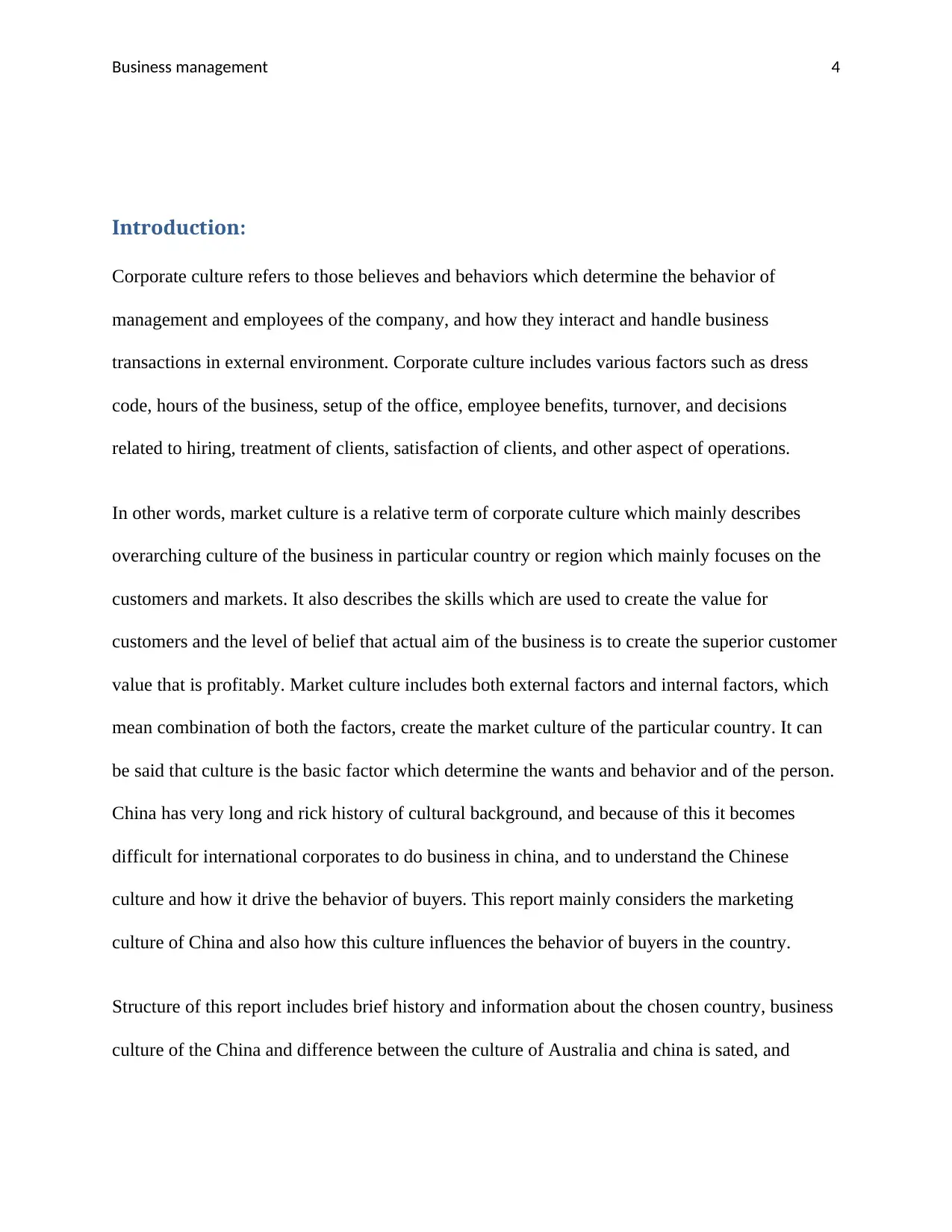
Business management 4
Introduction:
Corporate culture refers to those believes and behaviors which determine the behavior of
management and employees of the company, and how they interact and handle business
transactions in external environment. Corporate culture includes various factors such as dress
code, hours of the business, setup of the office, employee benefits, turnover, and decisions
related to hiring, treatment of clients, satisfaction of clients, and other aspect of operations.
In other words, market culture is a relative term of corporate culture which mainly describes
overarching culture of the business in particular country or region which mainly focuses on the
customers and markets. It also describes the skills which are used to create the value for
customers and the level of belief that actual aim of the business is to create the superior customer
value that is profitably. Market culture includes both external factors and internal factors, which
mean combination of both the factors, create the market culture of the particular country. It can
be said that culture is the basic factor which determine the wants and behavior and of the person.
China has very long and rick history of cultural background, and because of this it becomes
difficult for international corporates to do business in china, and to understand the Chinese
culture and how it drive the behavior of buyers. This report mainly considers the marketing
culture of China and also how this culture influences the behavior of buyers in the country.
Structure of this report includes brief history and information about the chosen country, business
culture of the China and difference between the culture of Australia and china is sated, and
Introduction:
Corporate culture refers to those believes and behaviors which determine the behavior of
management and employees of the company, and how they interact and handle business
transactions in external environment. Corporate culture includes various factors such as dress
code, hours of the business, setup of the office, employee benefits, turnover, and decisions
related to hiring, treatment of clients, satisfaction of clients, and other aspect of operations.
In other words, market culture is a relative term of corporate culture which mainly describes
overarching culture of the business in particular country or region which mainly focuses on the
customers and markets. It also describes the skills which are used to create the value for
customers and the level of belief that actual aim of the business is to create the superior customer
value that is profitably. Market culture includes both external factors and internal factors, which
mean combination of both the factors, create the market culture of the particular country. It can
be said that culture is the basic factor which determine the wants and behavior and of the person.
China has very long and rick history of cultural background, and because of this it becomes
difficult for international corporates to do business in china, and to understand the Chinese
culture and how it drive the behavior of buyers. This report mainly considers the marketing
culture of China and also how this culture influences the behavior of buyers in the country.
Structure of this report includes brief history and information about the chosen country, business
culture of the China and difference between the culture of Australia and china is sated, and
Paraphrase This Document
Need a fresh take? Get an instant paraphrase of this document with our AI Paraphraser
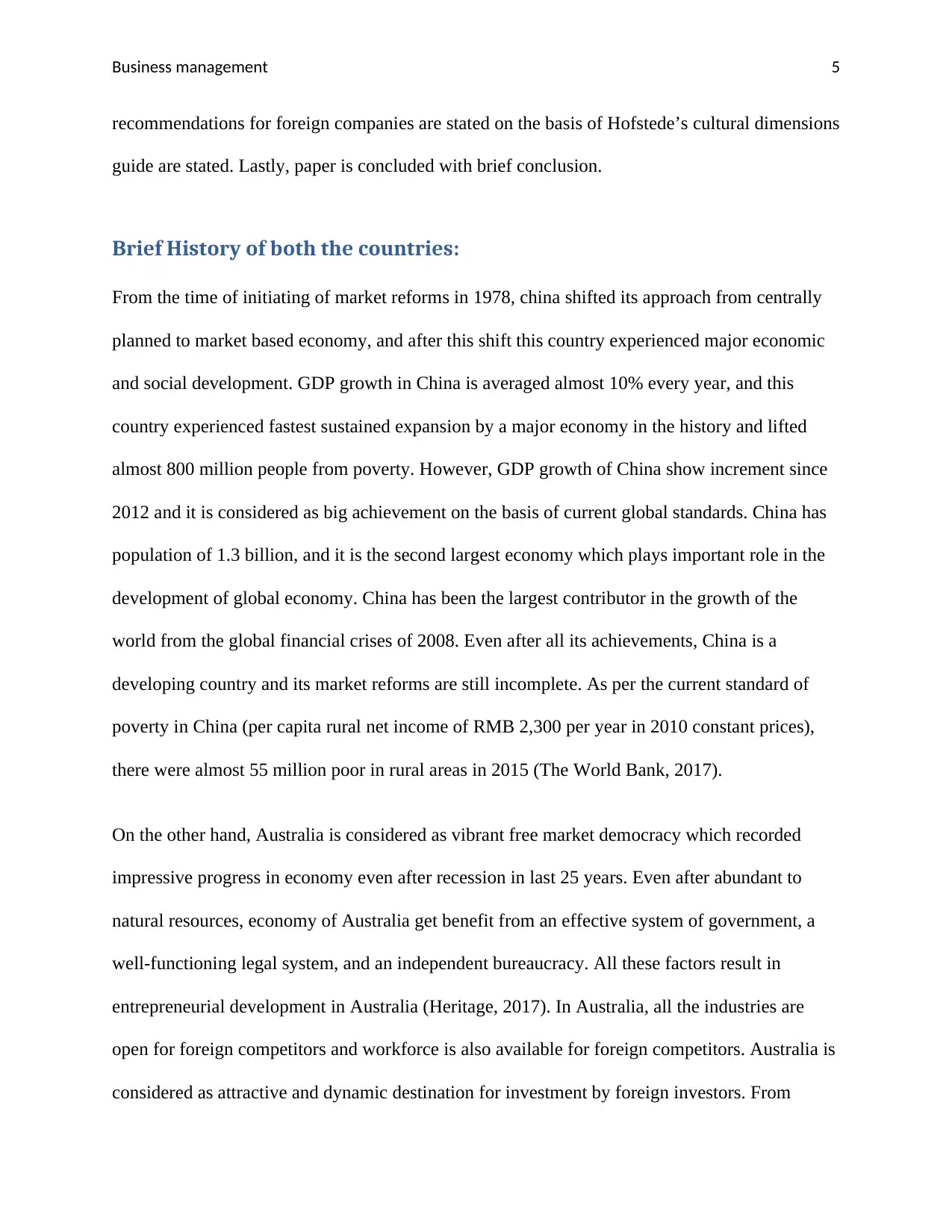
Business management 5
recommendations for foreign companies are stated on the basis of Hofstede’s cultural dimensions
guide are stated. Lastly, paper is concluded with brief conclusion.
Brief History of both the countries:
From the time of initiating of market reforms in 1978, china shifted its approach from centrally
planned to market based economy, and after this shift this country experienced major economic
and social development. GDP growth in China is averaged almost 10% every year, and this
country experienced fastest sustained expansion by a major economy in the history and lifted
almost 800 million people from poverty. However, GDP growth of China show increment since
2012 and it is considered as big achievement on the basis of current global standards. China has
population of 1.3 billion, and it is the second largest economy which plays important role in the
development of global economy. China has been the largest contributor in the growth of the
world from the global financial crises of 2008. Even after all its achievements, China is a
developing country and its market reforms are still incomplete. As per the current standard of
poverty in China (per capita rural net income of RMB 2,300 per year in 2010 constant prices),
there were almost 55 million poor in rural areas in 2015 (The World Bank, 2017).
On the other hand, Australia is considered as vibrant free market democracy which recorded
impressive progress in economy even after recession in last 25 years. Even after abundant to
natural resources, economy of Australia get benefit from an effective system of government, a
well-functioning legal system, and an independent bureaucracy. All these factors result in
entrepreneurial development in Australia (Heritage, 2017). In Australia, all the industries are
open for foreign competitors and workforce is also available for foreign competitors. Australia is
considered as attractive and dynamic destination for investment by foreign investors. From
recommendations for foreign companies are stated on the basis of Hofstede’s cultural dimensions
guide are stated. Lastly, paper is concluded with brief conclusion.
Brief History of both the countries:
From the time of initiating of market reforms in 1978, china shifted its approach from centrally
planned to market based economy, and after this shift this country experienced major economic
and social development. GDP growth in China is averaged almost 10% every year, and this
country experienced fastest sustained expansion by a major economy in the history and lifted
almost 800 million people from poverty. However, GDP growth of China show increment since
2012 and it is considered as big achievement on the basis of current global standards. China has
population of 1.3 billion, and it is the second largest economy which plays important role in the
development of global economy. China has been the largest contributor in the growth of the
world from the global financial crises of 2008. Even after all its achievements, China is a
developing country and its market reforms are still incomplete. As per the current standard of
poverty in China (per capita rural net income of RMB 2,300 per year in 2010 constant prices),
there were almost 55 million poor in rural areas in 2015 (The World Bank, 2017).
On the other hand, Australia is considered as vibrant free market democracy which recorded
impressive progress in economy even after recession in last 25 years. Even after abundant to
natural resources, economy of Australia get benefit from an effective system of government, a
well-functioning legal system, and an independent bureaucracy. All these factors result in
entrepreneurial development in Australia (Heritage, 2017). In Australia, all the industries are
open for foreign competitors and workforce is also available for foreign competitors. Australia is
considered as attractive and dynamic destination for investment by foreign investors. From
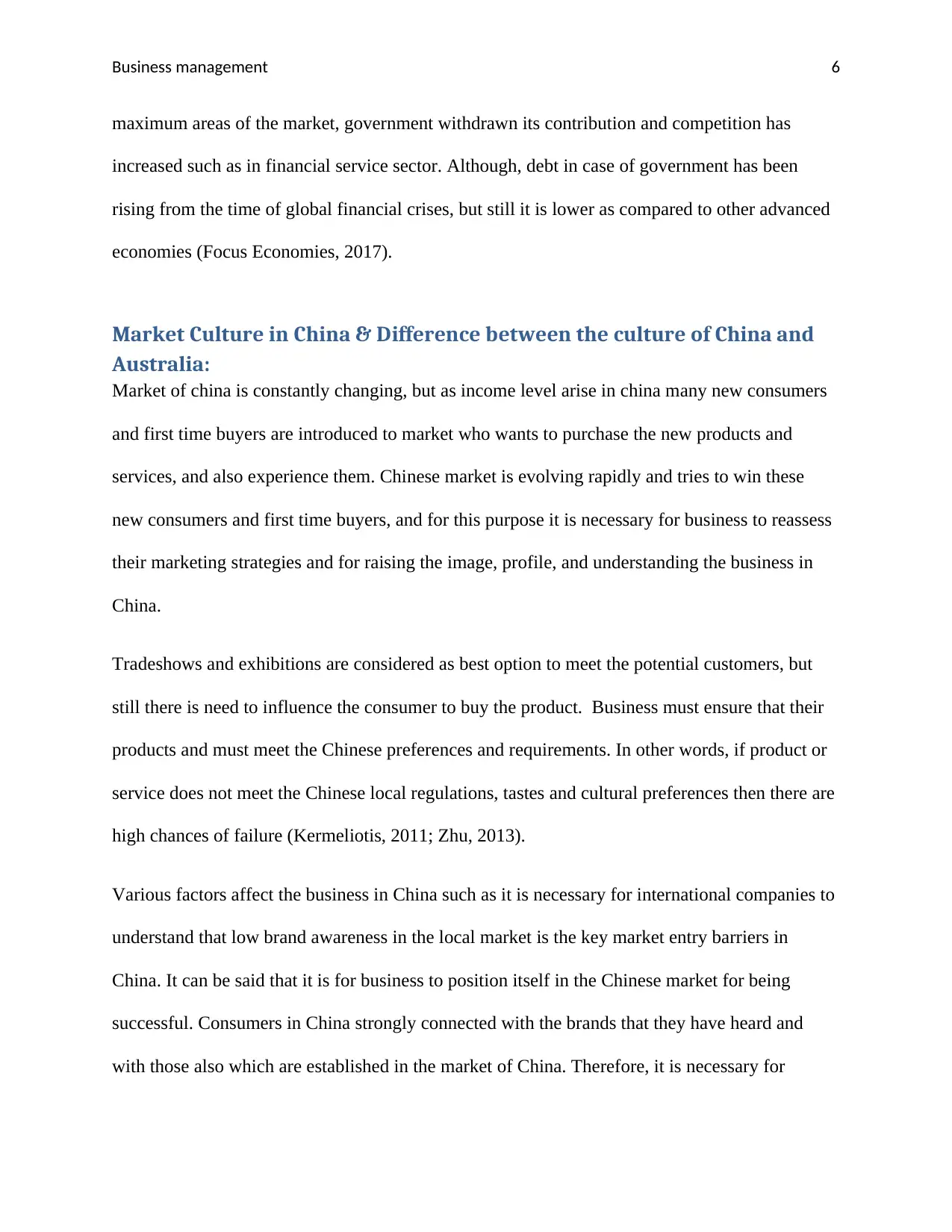
Business management 6
maximum areas of the market, government withdrawn its contribution and competition has
increased such as in financial service sector. Although, debt in case of government has been
rising from the time of global financial crises, but still it is lower as compared to other advanced
economies (Focus Economies, 2017).
Market Culture in China & Difference between the culture of China and
Australia:
Market of china is constantly changing, but as income level arise in china many new consumers
and first time buyers are introduced to market who wants to purchase the new products and
services, and also experience them. Chinese market is evolving rapidly and tries to win these
new consumers and first time buyers, and for this purpose it is necessary for business to reassess
their marketing strategies and for raising the image, profile, and understanding the business in
China.
Tradeshows and exhibitions are considered as best option to meet the potential customers, but
still there is need to influence the consumer to buy the product. Business must ensure that their
products and must meet the Chinese preferences and requirements. In other words, if product or
service does not meet the Chinese local regulations, tastes and cultural preferences then there are
high chances of failure (Kermeliotis, 2011; Zhu, 2013).
Various factors affect the business in China such as it is necessary for international companies to
understand that low brand awareness in the local market is the key market entry barriers in
China. It can be said that it is for business to position itself in the Chinese market for being
successful. Consumers in China strongly connected with the brands that they have heard and
with those also which are established in the market of China. Therefore, it is necessary for
maximum areas of the market, government withdrawn its contribution and competition has
increased such as in financial service sector. Although, debt in case of government has been
rising from the time of global financial crises, but still it is lower as compared to other advanced
economies (Focus Economies, 2017).
Market Culture in China & Difference between the culture of China and
Australia:
Market of china is constantly changing, but as income level arise in china many new consumers
and first time buyers are introduced to market who wants to purchase the new products and
services, and also experience them. Chinese market is evolving rapidly and tries to win these
new consumers and first time buyers, and for this purpose it is necessary for business to reassess
their marketing strategies and for raising the image, profile, and understanding the business in
China.
Tradeshows and exhibitions are considered as best option to meet the potential customers, but
still there is need to influence the consumer to buy the product. Business must ensure that their
products and must meet the Chinese preferences and requirements. In other words, if product or
service does not meet the Chinese local regulations, tastes and cultural preferences then there are
high chances of failure (Kermeliotis, 2011; Zhu, 2013).
Various factors affect the business in China such as it is necessary for international companies to
understand that low brand awareness in the local market is the key market entry barriers in
China. It can be said that it is for business to position itself in the Chinese market for being
successful. Consumers in China strongly connected with the brands that they have heard and
with those also which are established in the market of China. Therefore, it is necessary for
⊘ This is a preview!⊘
Do you want full access?
Subscribe today to unlock all pages.

Trusted by 1+ million students worldwide
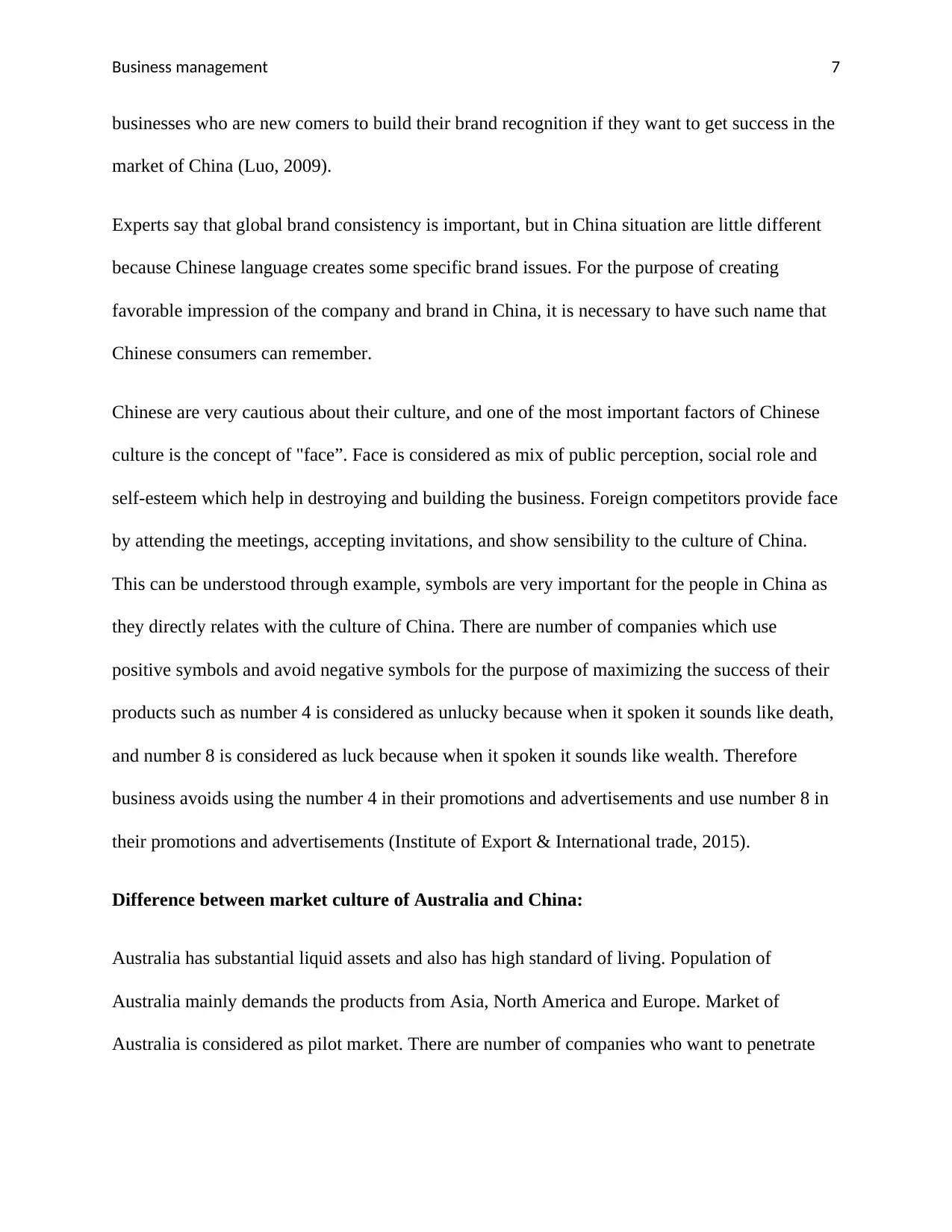
Business management 7
businesses who are new comers to build their brand recognition if they want to get success in the
market of China (Luo, 2009).
Experts say that global brand consistency is important, but in China situation are little different
because Chinese language creates some specific brand issues. For the purpose of creating
favorable impression of the company and brand in China, it is necessary to have such name that
Chinese consumers can remember.
Chinese are very cautious about their culture, and one of the most important factors of Chinese
culture is the concept of "face”. Face is considered as mix of public perception, social role and
self-esteem which help in destroying and building the business. Foreign competitors provide face
by attending the meetings, accepting invitations, and show sensibility to the culture of China.
This can be understood through example, symbols are very important for the people in China as
they directly relates with the culture of China. There are number of companies which use
positive symbols and avoid negative symbols for the purpose of maximizing the success of their
products such as number 4 is considered as unlucky because when it spoken it sounds like death,
and number 8 is considered as luck because when it spoken it sounds like wealth. Therefore
business avoids using the number 4 in their promotions and advertisements and use number 8 in
their promotions and advertisements (Institute of Export & International trade, 2015).
Difference between market culture of Australia and China:
Australia has substantial liquid assets and also has high standard of living. Population of
Australia mainly demands the products from Asia, North America and Europe. Market of
Australia is considered as pilot market. There are number of companies who want to penetrate
businesses who are new comers to build their brand recognition if they want to get success in the
market of China (Luo, 2009).
Experts say that global brand consistency is important, but in China situation are little different
because Chinese language creates some specific brand issues. For the purpose of creating
favorable impression of the company and brand in China, it is necessary to have such name that
Chinese consumers can remember.
Chinese are very cautious about their culture, and one of the most important factors of Chinese
culture is the concept of "face”. Face is considered as mix of public perception, social role and
self-esteem which help in destroying and building the business. Foreign competitors provide face
by attending the meetings, accepting invitations, and show sensibility to the culture of China.
This can be understood through example, symbols are very important for the people in China as
they directly relates with the culture of China. There are number of companies which use
positive symbols and avoid negative symbols for the purpose of maximizing the success of their
products such as number 4 is considered as unlucky because when it spoken it sounds like death,
and number 8 is considered as luck because when it spoken it sounds like wealth. Therefore
business avoids using the number 4 in their promotions and advertisements and use number 8 in
their promotions and advertisements (Institute of Export & International trade, 2015).
Difference between market culture of Australia and China:
Australia has substantial liquid assets and also has high standard of living. Population of
Australia mainly demands the products from Asia, North America and Europe. Market of
Australia is considered as pilot market. There are number of companies who want to penetrate
Paraphrase This Document
Need a fresh take? Get an instant paraphrase of this document with our AI Paraphraser
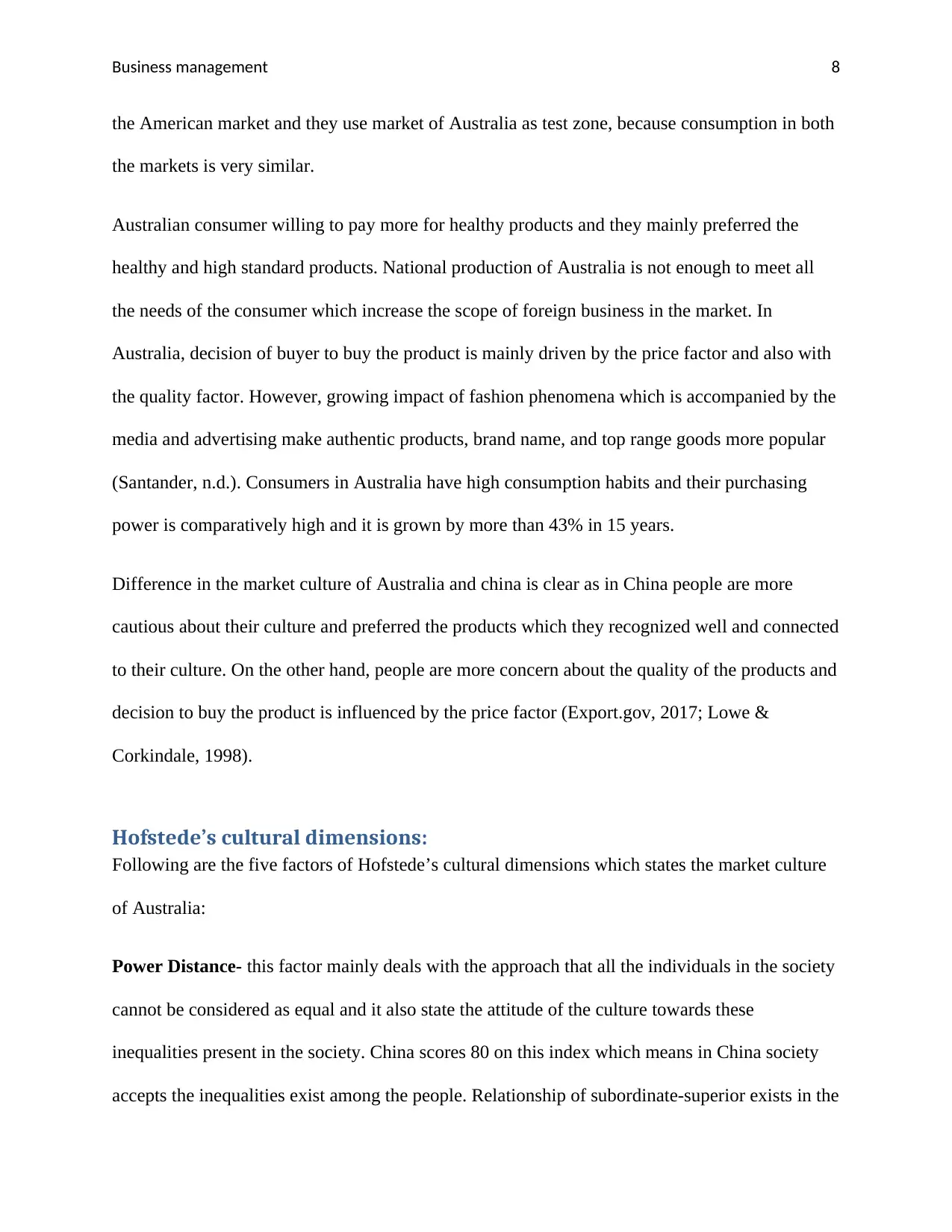
Business management 8
the American market and they use market of Australia as test zone, because consumption in both
the markets is very similar.
Australian consumer willing to pay more for healthy products and they mainly preferred the
healthy and high standard products. National production of Australia is not enough to meet all
the needs of the consumer which increase the scope of foreign business in the market. In
Australia, decision of buyer to buy the product is mainly driven by the price factor and also with
the quality factor. However, growing impact of fashion phenomena which is accompanied by the
media and advertising make authentic products, brand name, and top range goods more popular
(Santander, n.d.). Consumers in Australia have high consumption habits and their purchasing
power is comparatively high and it is grown by more than 43% in 15 years.
Difference in the market culture of Australia and china is clear as in China people are more
cautious about their culture and preferred the products which they recognized well and connected
to their culture. On the other hand, people are more concern about the quality of the products and
decision to buy the product is influenced by the price factor (Export.gov, 2017; Lowe &
Corkindale, 1998).
Hofstede’s cultural dimensions:
Following are the five factors of Hofstede’s cultural dimensions which states the market culture
of Australia:
Power Distance- this factor mainly deals with the approach that all the individuals in the society
cannot be considered as equal and it also state the attitude of the culture towards these
inequalities present in the society. China scores 80 on this index which means in China society
accepts the inequalities exist among the people. Relationship of subordinate-superior exists in the
the American market and they use market of Australia as test zone, because consumption in both
the markets is very similar.
Australian consumer willing to pay more for healthy products and they mainly preferred the
healthy and high standard products. National production of Australia is not enough to meet all
the needs of the consumer which increase the scope of foreign business in the market. In
Australia, decision of buyer to buy the product is mainly driven by the price factor and also with
the quality factor. However, growing impact of fashion phenomena which is accompanied by the
media and advertising make authentic products, brand name, and top range goods more popular
(Santander, n.d.). Consumers in Australia have high consumption habits and their purchasing
power is comparatively high and it is grown by more than 43% in 15 years.
Difference in the market culture of Australia and china is clear as in China people are more
cautious about their culture and preferred the products which they recognized well and connected
to their culture. On the other hand, people are more concern about the quality of the products and
decision to buy the product is influenced by the price factor (Export.gov, 2017; Lowe &
Corkindale, 1998).
Hofstede’s cultural dimensions:
Following are the five factors of Hofstede’s cultural dimensions which states the market culture
of Australia:
Power Distance- this factor mainly deals with the approach that all the individuals in the society
cannot be considered as equal and it also state the attitude of the culture towards these
inequalities present in the society. China scores 80 on this index which means in China society
accepts the inequalities exist among the people. Relationship of subordinate-superior exists in the
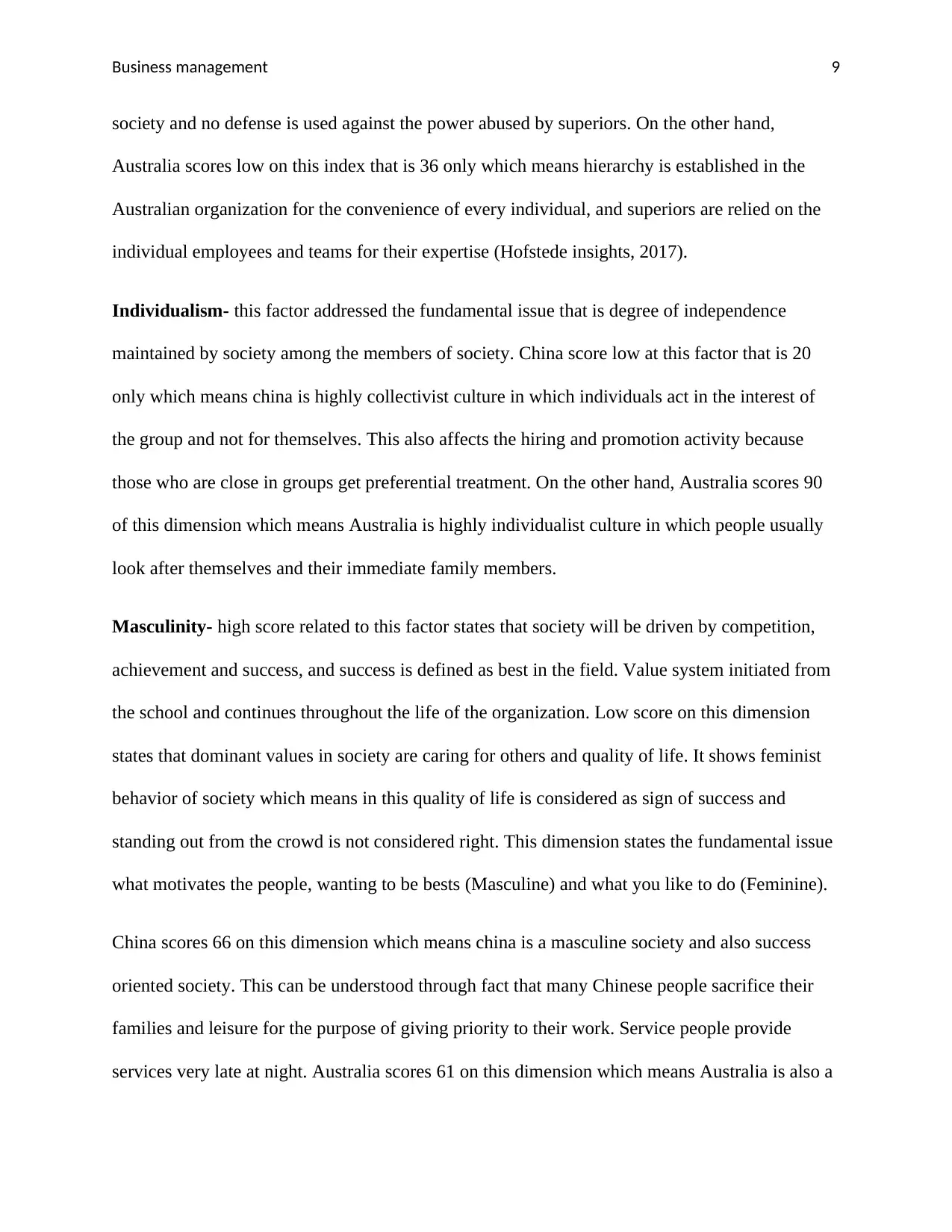
Business management 9
society and no defense is used against the power abused by superiors. On the other hand,
Australia scores low on this index that is 36 only which means hierarchy is established in the
Australian organization for the convenience of every individual, and superiors are relied on the
individual employees and teams for their expertise (Hofstede insights, 2017).
Individualism- this factor addressed the fundamental issue that is degree of independence
maintained by society among the members of society. China score low at this factor that is 20
only which means china is highly collectivist culture in which individuals act in the interest of
the group and not for themselves. This also affects the hiring and promotion activity because
those who are close in groups get preferential treatment. On the other hand, Australia scores 90
of this dimension which means Australia is highly individualist culture in which people usually
look after themselves and their immediate family members.
Masculinity- high score related to this factor states that society will be driven by competition,
achievement and success, and success is defined as best in the field. Value system initiated from
the school and continues throughout the life of the organization. Low score on this dimension
states that dominant values in society are caring for others and quality of life. It shows feminist
behavior of society which means in this quality of life is considered as sign of success and
standing out from the crowd is not considered right. This dimension states the fundamental issue
what motivates the people, wanting to be bests (Masculine) and what you like to do (Feminine).
China scores 66 on this dimension which means china is a masculine society and also success
oriented society. This can be understood through fact that many Chinese people sacrifice their
families and leisure for the purpose of giving priority to their work. Service people provide
services very late at night. Australia scores 61 on this dimension which means Australia is also a
society and no defense is used against the power abused by superiors. On the other hand,
Australia scores low on this index that is 36 only which means hierarchy is established in the
Australian organization for the convenience of every individual, and superiors are relied on the
individual employees and teams for their expertise (Hofstede insights, 2017).
Individualism- this factor addressed the fundamental issue that is degree of independence
maintained by society among the members of society. China score low at this factor that is 20
only which means china is highly collectivist culture in which individuals act in the interest of
the group and not for themselves. This also affects the hiring and promotion activity because
those who are close in groups get preferential treatment. On the other hand, Australia scores 90
of this dimension which means Australia is highly individualist culture in which people usually
look after themselves and their immediate family members.
Masculinity- high score related to this factor states that society will be driven by competition,
achievement and success, and success is defined as best in the field. Value system initiated from
the school and continues throughout the life of the organization. Low score on this dimension
states that dominant values in society are caring for others and quality of life. It shows feminist
behavior of society which means in this quality of life is considered as sign of success and
standing out from the crowd is not considered right. This dimension states the fundamental issue
what motivates the people, wanting to be bests (Masculine) and what you like to do (Feminine).
China scores 66 on this dimension which means china is a masculine society and also success
oriented society. This can be understood through fact that many Chinese people sacrifice their
families and leisure for the purpose of giving priority to their work. Service people provide
services very late at night. Australia scores 61 on this dimension which means Australia is also a
⊘ This is a preview!⊘
Do you want full access?
Subscribe today to unlock all pages.

Trusted by 1+ million students worldwide
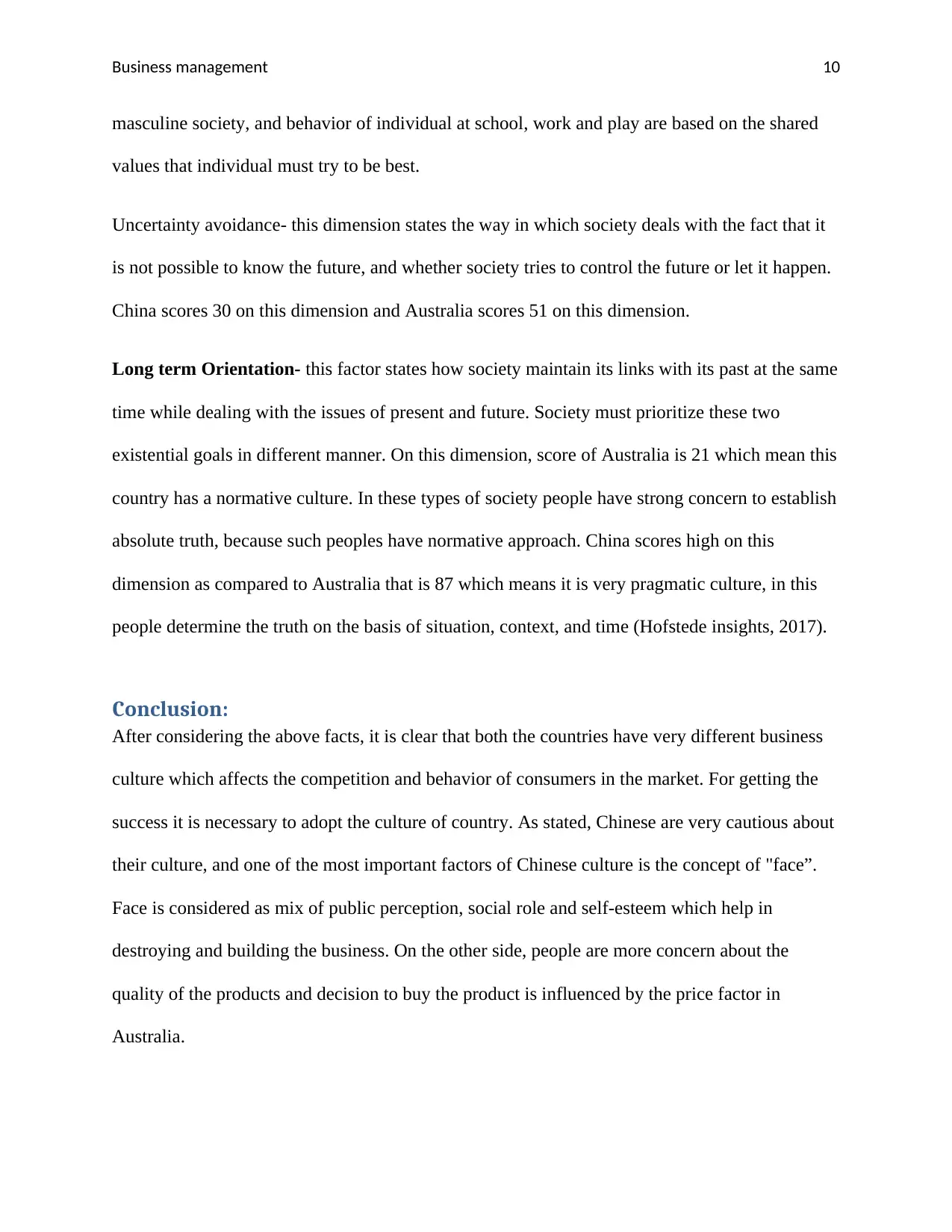
Business management 10
masculine society, and behavior of individual at school, work and play are based on the shared
values that individual must try to be best.
Uncertainty avoidance- this dimension states the way in which society deals with the fact that it
is not possible to know the future, and whether society tries to control the future or let it happen.
China scores 30 on this dimension and Australia scores 51 on this dimension.
Long term Orientation- this factor states how society maintain its links with its past at the same
time while dealing with the issues of present and future. Society must prioritize these two
existential goals in different manner. On this dimension, score of Australia is 21 which mean this
country has a normative culture. In these types of society people have strong concern to establish
absolute truth, because such peoples have normative approach. China scores high on this
dimension as compared to Australia that is 87 which means it is very pragmatic culture, in this
people determine the truth on the basis of situation, context, and time (Hofstede insights, 2017).
Conclusion:
After considering the above facts, it is clear that both the countries have very different business
culture which affects the competition and behavior of consumers in the market. For getting the
success it is necessary to adopt the culture of country. As stated, Chinese are very cautious about
their culture, and one of the most important factors of Chinese culture is the concept of "face”.
Face is considered as mix of public perception, social role and self-esteem which help in
destroying and building the business. On the other side, people are more concern about the
quality of the products and decision to buy the product is influenced by the price factor in
Australia.
masculine society, and behavior of individual at school, work and play are based on the shared
values that individual must try to be best.
Uncertainty avoidance- this dimension states the way in which society deals with the fact that it
is not possible to know the future, and whether society tries to control the future or let it happen.
China scores 30 on this dimension and Australia scores 51 on this dimension.
Long term Orientation- this factor states how society maintain its links with its past at the same
time while dealing with the issues of present and future. Society must prioritize these two
existential goals in different manner. On this dimension, score of Australia is 21 which mean this
country has a normative culture. In these types of society people have strong concern to establish
absolute truth, because such peoples have normative approach. China scores high on this
dimension as compared to Australia that is 87 which means it is very pragmatic culture, in this
people determine the truth on the basis of situation, context, and time (Hofstede insights, 2017).
Conclusion:
After considering the above facts, it is clear that both the countries have very different business
culture which affects the competition and behavior of consumers in the market. For getting the
success it is necessary to adopt the culture of country. As stated, Chinese are very cautious about
their culture, and one of the most important factors of Chinese culture is the concept of "face”.
Face is considered as mix of public perception, social role and self-esteem which help in
destroying and building the business. On the other side, people are more concern about the
quality of the products and decision to buy the product is influenced by the price factor in
Australia.
Paraphrase This Document
Need a fresh take? Get an instant paraphrase of this document with our AI Paraphraser
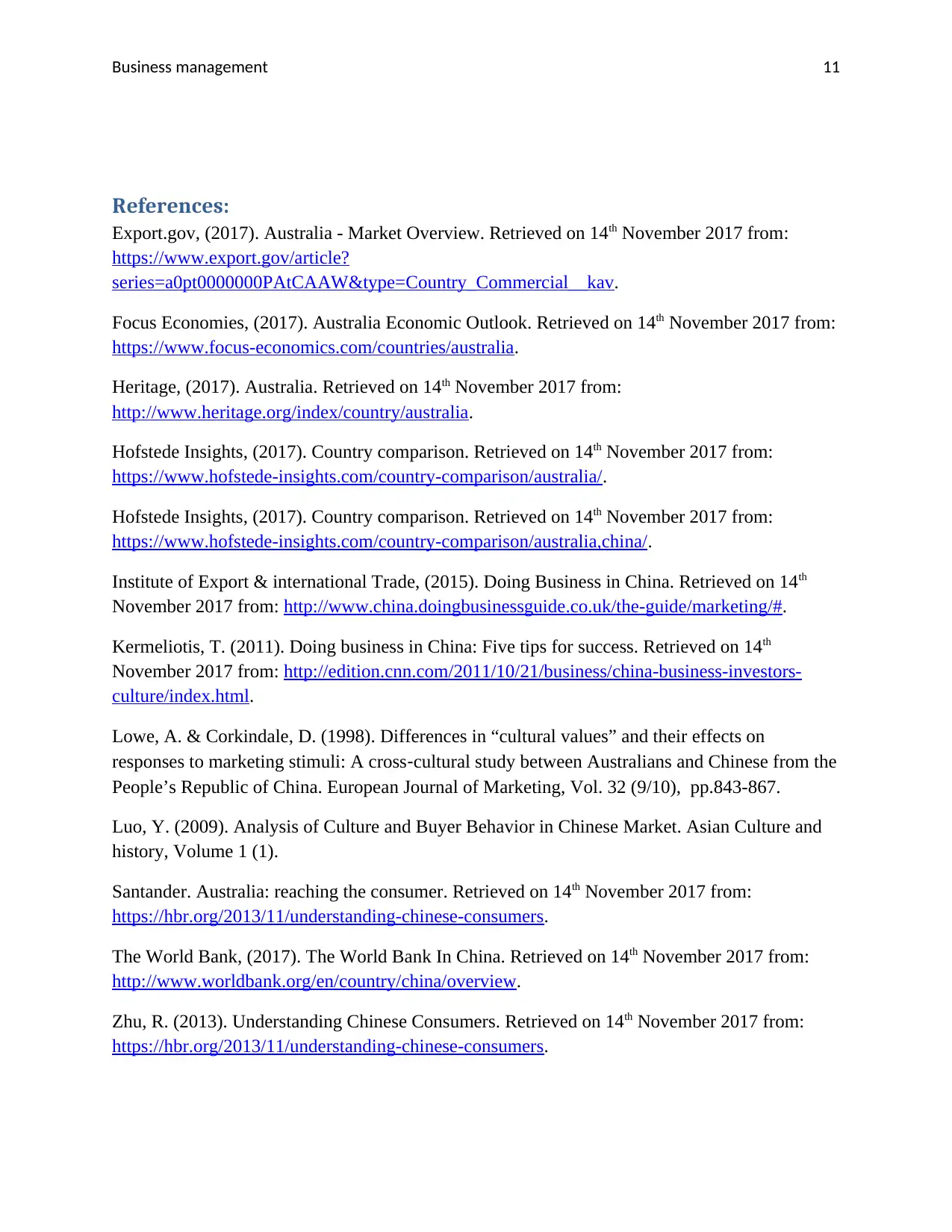
Business management 11
References:
Export.gov, (2017). Australia - Market Overview. Retrieved on 14th November 2017 from:
https://www.export.gov/article?
series=a0pt0000000PAtCAAW&type=Country_Commercial__kav.
Focus Economies, (2017). Australia Economic Outlook. Retrieved on 14th November 2017 from:
https://www.focus-economics.com/countries/australia.
Heritage, (2017). Australia. Retrieved on 14th November 2017 from:
http://www.heritage.org/index/country/australia.
Hofstede Insights, (2017). Country comparison. Retrieved on 14th November 2017 from:
https://www.hofstede-insights.com/country-comparison/australia/.
Hofstede Insights, (2017). Country comparison. Retrieved on 14th November 2017 from:
https://www.hofstede-insights.com/country-comparison/australia,china/.
Institute of Export & international Trade, (2015). Doing Business in China. Retrieved on 14th
November 2017 from: http://www.china.doingbusinessguide.co.uk/the-guide/marketing/#.
Kermeliotis, T. (2011). Doing business in China: Five tips for success. Retrieved on 14th
November 2017 from: http://edition.cnn.com/2011/10/21/business/china-business-investors-
culture/index.html.
Lowe, A. & Corkindale, D. (1998). Differences in “cultural values” and their effects on
responses to marketing stimuli: A cross‐cultural study between Australians and Chinese from the
People’s Republic of China. European Journal of Marketing, Vol. 32 (9/10), pp.843-867.
Luo, Y. (2009). Analysis of Culture and Buyer Behavior in Chinese Market. Asian Culture and
history, Volume 1 (1).
Santander. Australia: reaching the consumer. Retrieved on 14th November 2017 from:
https://hbr.org/2013/11/understanding-chinese-consumers.
The World Bank, (2017). The World Bank In China. Retrieved on 14th November 2017 from:
http://www.worldbank.org/en/country/china/overview.
Zhu, R. (2013). Understanding Chinese Consumers. Retrieved on 14th November 2017 from:
https://hbr.org/2013/11/understanding-chinese-consumers.
References:
Export.gov, (2017). Australia - Market Overview. Retrieved on 14th November 2017 from:
https://www.export.gov/article?
series=a0pt0000000PAtCAAW&type=Country_Commercial__kav.
Focus Economies, (2017). Australia Economic Outlook. Retrieved on 14th November 2017 from:
https://www.focus-economics.com/countries/australia.
Heritage, (2017). Australia. Retrieved on 14th November 2017 from:
http://www.heritage.org/index/country/australia.
Hofstede Insights, (2017). Country comparison. Retrieved on 14th November 2017 from:
https://www.hofstede-insights.com/country-comparison/australia/.
Hofstede Insights, (2017). Country comparison. Retrieved on 14th November 2017 from:
https://www.hofstede-insights.com/country-comparison/australia,china/.
Institute of Export & international Trade, (2015). Doing Business in China. Retrieved on 14th
November 2017 from: http://www.china.doingbusinessguide.co.uk/the-guide/marketing/#.
Kermeliotis, T. (2011). Doing business in China: Five tips for success. Retrieved on 14th
November 2017 from: http://edition.cnn.com/2011/10/21/business/china-business-investors-
culture/index.html.
Lowe, A. & Corkindale, D. (1998). Differences in “cultural values” and their effects on
responses to marketing stimuli: A cross‐cultural study between Australians and Chinese from the
People’s Republic of China. European Journal of Marketing, Vol. 32 (9/10), pp.843-867.
Luo, Y. (2009). Analysis of Culture and Buyer Behavior in Chinese Market. Asian Culture and
history, Volume 1 (1).
Santander. Australia: reaching the consumer. Retrieved on 14th November 2017 from:
https://hbr.org/2013/11/understanding-chinese-consumers.
The World Bank, (2017). The World Bank In China. Retrieved on 14th November 2017 from:
http://www.worldbank.org/en/country/china/overview.
Zhu, R. (2013). Understanding Chinese Consumers. Retrieved on 14th November 2017 from:
https://hbr.org/2013/11/understanding-chinese-consumers.

Business management 12
⊘ This is a preview!⊘
Do you want full access?
Subscribe today to unlock all pages.

Trusted by 1+ million students worldwide
1 out of 12
Related Documents
Your All-in-One AI-Powered Toolkit for Academic Success.
+13062052269
info@desklib.com
Available 24*7 on WhatsApp / Email
![[object Object]](/_next/static/media/star-bottom.7253800d.svg)
Unlock your academic potential
Copyright © 2020–2025 A2Z Services. All Rights Reserved. Developed and managed by ZUCOL.




